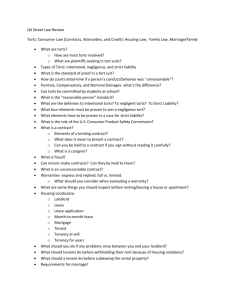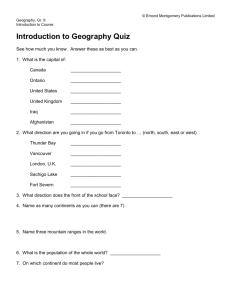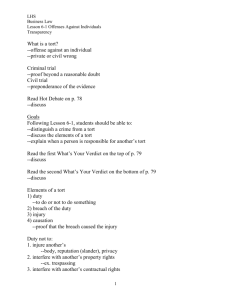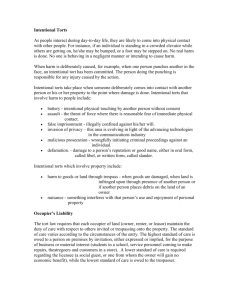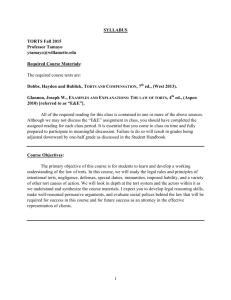Tort
advertisement
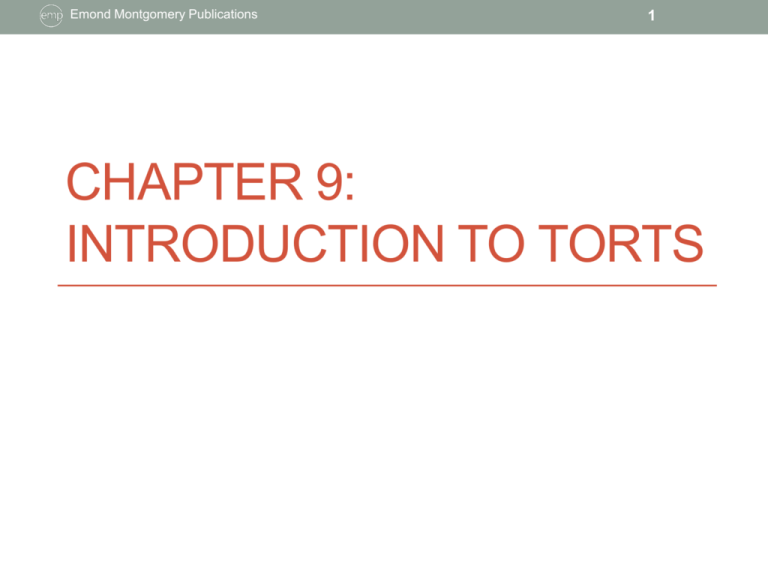
Emond Montgomery Publications 1 CHAPTER 9: INTRODUCTION TO TORTS Emond Montgomery Publications 2 Chapter 9: Introduction to Torts Learning Outcomes • Describe the four basic elements of a tort. • Understand what is meant by duty of care and standard of care. • Explain the general classification system for torts. • Explain the concept of intent as it relates to torts. • List and distinguish the different levels of intent (guilty mentality) recognized in tort law. • Understand which level of intent is required for each of the general classes of tort. Emond Montgomery Publications 3 Introduction • Tort: a wrong that occurs between two or more parties • Doctrine of torts is used to argue lawsuits that require 1. proof of a duty of care and 2. failure to meet that duty • Law of torts applies to harm … • to people • to property and intangibles Emond Montgomery Publications 4 The Four Elements: Duty, Breach, Causation and Harm 1. DUTY •In order to have a tort action, the person who committed a “wrong” must owe another party a duty of care •If there is no duty of care, there is no tort Emond Montgomery Publications 5 The Four Elements: Duty, Breach, Causation, and Harm 2. BREACH •A breach occurs where the tortfeasor does not live up to his duty of care •A breach of the duty of care will occur when the actions of the tortfeasor do not live up to the “standard of care” •Defining what is the standard of care is the focus of much tort litigation Emond Montgomery Publications 6 The Four Elements: Duty, Breach, Causation, and Harm 3. CAUSATION • The breach of the duty of care must be the causal link to the harm done • If breach of the duty of care is not the cause of the harm, then the tort action will not succeed Emond Montgomery Publications 7 The Four Elements: Duty, Breach, Causation and Harm 4. HARM • The person who brings a tort action must be able to show that they suffered a harm that is compensable by money • Example: personal injury, damage to property, etc. • The law of torts does not compensate for non- compensable harms • Example: a broken heart Emond Montgomery Publications 8 Classification of Torts TORTFEASOR’S INTENT •Torts are often classified according to the nature and level of intent possessed by the tortfeasor when carrying out the tort •Levels of intent in tort law: Emond Montgomery Publications 9 Classification of Torts (cont’d) THE MAJOR CATEGORIES – Intentional Torts •Intentional torts are wrongs undertaken with the intent to do the act which causes harm •Some intentional torts may also be the basis for criminal proceedings (e.g., battery/assault) •Intentional torts include acts that cause harm to people, physical property, or intangible property • Examples: battery, assault, defamation, false imprisonment, malicious prosecution, fraud, deceit, abuse of process Emond Montgomery Publications 10 Classification of Torts (cont’d) THE MAJOR CATEGORIES– Transferred Intent •Torts of transferred intent were developed to address situations in which the defendant’s intentional act was directed at one party but harmed a different party •As long as the defendant intended the act and the act was done, it does not matter if the victim was the intended victim • Example: An employee slashes the tires of what he believes is his employer’s car. The car is actually a rental car. The absence of wrongful intent toward the rental company does not negate the tort. Emond Montgomery Publications 11 Classification of Torts (cont’d) THE MAJOR CATEGORIES – Negligence •Negligence is the heart of tort law • Examples: occupiers’ liability, product liability, professional malpractice •Covers a range of levels of intent, including: 1.willful blindness (ignoring the likely harmful consequences) 2.recklessness (acting without considering consequences) 3.carelessness (acting without sufficient thought) 4.accident (fairly honest, potentially preventable error) Emond Montgomery Publications 12 Classification of Torts (cont’d) THE MAJOR CATEGORIES – Vicarious Liability, Strict Liability, and Absolute Liability •Vicarious liability: liability of a principal for the negligent or tortious acts of the principal’s agent done within the scope of the agent’s authority or employment •Strict liability: liability that is imposed even though no negligence or intentional tort occurred •Absolute liability: liability that is imposed automatically when certain conditions are met, without reference to negligence or intent Emond Montgomery Publications 13 The Classification of Torts (cont’d) NUISANCE •Nuisance is a tort based on conditions prevailing or activities carried out on land •Plaintiff must prove that the defendant’s actions or use of their land affect’s the plaintiff’s use or enjoyment of their land •Usually between neighbours Emond Montgomery Publications Classification of Torts (cont’d) OTHER CLASSIFICATION CRITERIA • Intentional torts can be divided into five categories: 1. Torts based on injury to the person or to reputation 2. Torts based on harm to chattels 3. Torts based on interference with land 4. Torts based on inferences with rights or legal process 5. Torts based on harm to business interests 14

